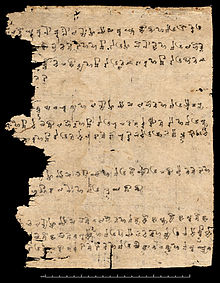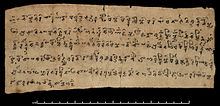Saka language
| Saka | |
|---|---|
| Khotanese, Tumshuqese | |
| Native to | Kingdom of Khotan and Tumxuk (today Xinjiang, China) |
| Era | 100 BCE – 1000 CE |
| Dialects |
|
| Brāhmī | |
| Language codes | |
| ISO 639-2 | ho |
| ISO 639-3 | Either:kho – Khotanesextq – Tumshuqese |
kho (Khotanese) | |
xtq (Tumshuqese) | |



The name "Saka" is often used for a language that is sometimes referred to as "Eastern Iranian", "Khotanese", "Tumshuqese", and in contemporary documents was known as hvatanai.[1]. Documents written on wood and paper are known from the sites of Khotan and Tumshuq and were written in modified Brahmi script (with the addition of extra characters over time and unusual conjuncts such as ys for z).[2] These documents date from the fourth to the eleventh century and the two sites have different dialects of the language. The dialect found at Tumshuq is considered to be more archaic than that found at Khotan.[3] The nearest living dialects of Saka are spoken in the Pamir mountains, particularly the Wakhi language.
History
The two known dialects of Saka are associated with a movement of Scythian people. No invasion of the region is recorded in Chinese records and one theory is that two tribes of Saka, speaking the dialects, settled in the region in about 200 BC before the Chinese accounts commence [4].
Texts
Other than an inscription from Issyk Kurgan that it is tentatively identified as the Khotanese dialect of Saka (but written in Kharoshthi) all of the surviving documents written in this language originate from Khotan or Tumshuq. The vast majority of the documents are from Khotan, the International Dunhuang Project has 2329 documents in Khotanese as opposed to just 11 in Tumshuqese. The earliest texts, from the fourth century, are mostly religious documents. There were several Buddhist monasteries (vihara) in Khotan and Buddhist translations are common at all periods of the documents. There are many reports (called haṣḍa aurāsa) to the royal court which are of historical importance, as well as private documents. For an example of a document Or.6400/2.3.
Notes
- ^ Bailey, H W (1939). "The Rama Story in Khotanese". Journal of the American Oriental Society. 59 (4): 460.
{{cite journal}}: Unknown parameter|month=ignored (help) - ^ Bailey, H W (1970). "The Ancient Kingdom of Khotan". British Institute of Persian Studies. 8: 65–72.
- ^ Masson], [editors, A.H. Dani, V.M. (1992). History of civilizations of Central Asia. Paris: UNESCO. p. 283. ISBN 92-3-103211-9.
{{cite book}}:|first=has generic name (help)CS1 maint: multiple names: authors list (link) - ^ Bailey, H W (1970). "The Ancient Kingdom of Khotan". British Institute of Persian Studies. 8: 68.
References
Sources
International Dunhuang Project Bailey, H W (1979) Dictionary of Khotan Saka, Cambridge University Press
Further reading
- Encyclopedia Iranica "Iranian Languages" http://www.iranicaonline.org/articles/central-asia-xiii
- Emmerick, R. E., & Pulleyblank, E. G. (1993). A Chinese text in Central Asian Brahmi script: new evidence for the pronunciation of Late Middle Chinese and Khotanese. Roma: Istituto italiano per il Medio ed Estremo Oriente. (On connections between Chinese and Khotanese, such as loan words and pronunciations)
